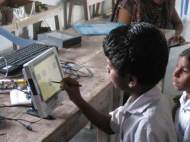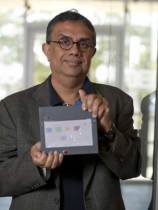Indian school children to test new, low-cost electronic notepad
 Thanks to a partnership between Singapore’s Nanyang Technological University (NTU), Houston’s Rice University and an Indian nonprofit, Villages for Development and Learning Foundation (ViDAL), some of the estimated 100 million Indian children who attend schools without electricity may soon have access to one of the world’s most advanced electronic notepads.
Thanks to a partnership between Singapore’s Nanyang Technological University (NTU), Houston’s Rice University and an Indian nonprofit, Villages for Development and Learning Foundation (ViDAL), some of the estimated 100 million Indian children who attend schools without electricity may soon have access to one of the world’s most advanced electronic notepads.
Dubbed I-slate, the device is in development at the Institute of Sustainable and Applied Infodynamics (ISAID) at NTU. The first prototypes of the I-slate, which were built at NTU this summer by a team that included three Rice undergraduates, are set to undergo their second round of tests in India later this month.
Krishna Palem, a Rice University professor, who directs ISAID, said the I-slate is the first of a series of electronic notepads being built around a new class of green, power-stingy microchips that use a fraction of the electricity of today’s computer chips. Under development in partnership between ISAID and Switzerland’s Center for Electronics and Microtechnology, the chips will make it possible for the I-slate to run on solar power from panels similar to those used in hand-held calculators.
“Children in Indian village schools are just like their peers anywhere in the world: eager to learn, tech savvy, and willing to try new pedagogical tools that engage their creative minds”, said Rajeswari Pingali, ViDAL president. “The I-slate can help bring the marvels of ICT into thousands of rural schools and contribute to an improved learning experience.”
A nonprofit based in Hyderabad, ViDAL is partnering with ISAID to test the first I-slates in Mohd Hussainpalli village, some 70 miles southwest of Hyderabad in a drought-prone area.
“There are many factors involved – good nutrition, a good psychological environment, attentive teachers and appropriate learning and teaching tools. We can’t control all of these, but ViDAL is active in areas where we can make a difference, like nutrition and teaching tools. We believe the I-slate has great potential once its design caters to local needs and strengths”, Pingali added.
Rice undergraduates Lauren Pemberton and Shelby Reinhardt were first introduced to the project in a spring course on sustainable engineering, spent 10 weeks this summer at NTU writing a self-directed mathematics teaching application for the first I-slate prototypes. In early August, Reinhardt and Pemberton accompanied Pingali and Vincent Mooney, ISAID’s chief I-slate hardware architect, to see how a class of 10- to 13-year-olds liked the new device.
“Most of these students have never used a computer or seen a video game, so we really didn’t know how they’d react to the I-slate”, said Reinhardt, a junior chemical engineering major.
“They immediately picked up on the technology”, said Pemberton, a junior cognitive sciences major. “They clearly didn’t like some of the things we expected to work really well, like the button placement, but they loved the scratch-pad application which was added at the last minute.”
Social scientists and volunteers from ViDAL will work with Palem and Mooney’s ISAID team to refine both the I-slate hardware and teaching content. The team plans to conduct a long-term test at Hussainpalli Government School to track the academic progress of students who use the I-slate.
“Developing an electronic notepad that is green, requires very little energy to operate and that could even run on solar energy in future is in line with NTU’s emphasis on sustainability research”, said NTU President Su Guaning. “The research will not just help in the sustainability of our planet but the development of such sustainable, low-cost technologies will also help the poorer communities in the world to close the digital divide. It will be life-changing and it will help to improve lives.”










Good to note this. It is long overdue.
Dr.A.Jagadeesh Nellore(AP)
Let us hope it won’t be another project of HIGH PROMISE AND LOW PERFORMANCE.
Dr.A.Jagadeesh Nellore(AP),India
author
ISAID team members in Switzerland, Singapore and the U.S. are developing the first production version of the low-power computer chip. Solar-powered I-slates containing the new chips are due for production in mid-2012.
In March, the researchers examined whether the I-slate helped students’ improve in mathematics. Students use a stylus to tap and write out mathematics problems on the I-slate. They get immediate feedback about correct and incorrect answers. When answers are incorrect, the machine gives hints and tips about how to correct mistakes.
Using a series of sophisticated measures, the ISAID team analyzed each student’s performance and improvement. Students were also surveyed about the features of the I-slate that were most and least useful. Palem said the tests and surveys confirmed the I-slate was effective and provided the ISAID team with valuable information needed to finalize the I-slate’s design.
“We know more than 90 percent of what we need to know at this point”, said Palem. “We’ve settled the hardware questions, and that is central to the manner in which the lessons are taught and the manner in which the students interact with the I-slate.”